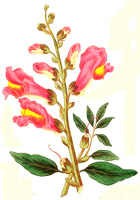
"They're nothing but long-legged rats!" a gardener friend once said. They dine on expensive hybrid roses. They take a bite out of each of the melons on the vine, spoiling all before they move on. They'll yank the broccoli and lettuce out of the ground, and make short work of the perennial bed.
They're Bambis in Suburbia,
Over the Hedge in 3-D real life, and not nearly so funny when they gobble up the plants that you've poured money and sweat into.
Within a half mile of our house is an abandoned orchard where the deer roam, and sometimes wander out into the surrounding neighborhoods. Recently the bulldozers have been at work, since someone plans to subdivide and build on the site (exactly who we don't know, nor do we know what the plans are, as they seem to change as often as
Madonna's new "look"), pushing the deer out of their former home. They haven't turned up in our yard yet, but as there is an overgrown wood nearby, and a convenient back alley access, it's only a matter of time. Others in the neighborhood have not been so fortunate. Their excitement about the ooh-so-cute brown-eyed delicate-looking creatures quickly turns to rage as Bambi bites all the flowers off of the tea rose.
Why do they do it? Why do the take a bite here, a bite there, and ruin all the pumpkins or melons in the patch instead of feeding on just one? Because they're browsers, not grazers. It's the way that deer eat. They're also edge species, moving from wood to meadow and back again, and when we carve up the woods to make suburbs, we provide more edges than nature ever intended, increasing their habitat many times over. They we lay out a banquet of roses and veggies for them. What else are they going to do but belly up to the buffet and sample everything, then trot off to the woods to make more little deer?
When I was a kid, though, I grew up in the country, where deer made regular treks across the front lawn and through the garden. We tried all the "sure-fire" remedies that we'd heard recommended. We hung aluminum pie tins out where they'd rattle in the breezes. It helped a bit with the birds, but the deer were unfazed. We hung strong-smelling soap -- Lifebuoy was the supposed magic brand -- but it had so little effect, we half-suspected the deer were showering with it. We scattered human hair around, but the deer seemed so used to the presence of humans already that this barely registered with them. We tried sprinkling blood meal around. Great fertilizer, lousy deer repellant. The only "deer-proof" plants that were ever actually deer proof seemed to be the daffodils. The rest were fair game, even if they were only second choice, and the only thing left during the dry season of August and September.
Besides, by the time you apply all the usual remedies, and reapply them frequently, you'll spend all of your gardening time hanging up noisemakers and applying noxious mixtures. Who wants a smelly, noisy garden anyway?
The only thing that ever worked were physical barriers. A simple fence made of metal stakes with twine slowed them down a bit, at least in the raised bed in the turnaround where the roses were. Late in the summer when everything dried up, they'd still manage to hop over this. The electric fence that Dad strung around the vegetable garden did a better job, as did the wire mesh cages -- simple cylinders of hardware cloth -- that went up around the blueberry bushes. And a taller, more permanent fence that he built around the permanent garden, where the berries and grapes were, managed to protect those plantings reasonably well.
I think it's a cycle that all gardeners go through. First you try what amounts to little folk charms because someone swears they'll work and they're cheap -- cheap that is until you lose that expensive perennial that you've been nursing along. Eventually you realize that "cheap" means spending the money to do things right in the first place. Up goes the fence, and the deer move on.
Since the configuration of our yard doesn't make it easy to fence, I'm hoping that the deer never discover us. But if they do -- well, I'd better start setting something aside against that day, because fencing everything in isn't going to be cheap. Either that, or build wire mesh covers, though I don't fancy keeping a cage farm.
The Washington Post has more on the subject, here:
Not Yours to Munch, Deer.


















